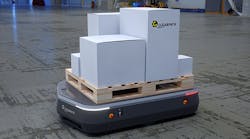A swarm of robots will soon be overtaking John Deere’s Horicon, Wis., plant.
Sometime this year, a fleet of new-generation AGVs will begin zipping through the lanes of the company’s assembly line, hauling parts and materials across the plant in an efficient, automated buzz.
On the face of it, there is nothing too exciting about this news. Automated Guided Vehicles are nothing new to the market; they have been scurrying around plants in one form or another for decades already.
But none of them have ever been quite like these.
John Deere’s fleet will mark the latest deployment of OTTO 1500—a fully self-driving, autonomous robotic vehicle built by a new player in the space, Ontario-based Clearpath Robotics.
The machines are capable of transporting up to 3,000 pounds of goods through congested plant and warehouse environments without the need for drivers, supervision, or guidance infrastructure.
That last detail is what makes this technology exciting.
Traditional AGVs require a lot of work and a lot of free space to run safely and efficiently. In the past, this has meant tying them to magnetic strips or grids of barcodes crisscrossing human-free transport lanes.
But not anymore.
According to Clearpath co-founder and CEO, Matt Rendall, OTTO taps into the same sensor-driven, high-computing backbone of Google’s self-driving car to safely and efficiently transport supplies along the same plant and warehouse paths populated by workers and equipment.
“The key difference between OTTO and previous generations of this technology is that fundamentally OTTO is off the track,” explains Rendall.
He likens the distinction to the difference between subway systems and taxis in a busy city.
“There is a time and a place for a subway system,” he says. “But when speed and efficiency are needed, there is also a time and a place for taxi cabs.”
However, creating a robot smart enough to safely traverse a busy plant is a far cry from trusting an experienced driver to get you to the office on time.
The Human-Robot Trust Fall
From an operations perspective, having a fleet of pilot-less robots carting pieces and parts along an optimized path through the assembly floor sounds like a dream come true. For the workers on that floor, however, that scenario can be a bit more alarming.
“We built OTTO to go anywhere in the factory as long as it ended up in the right location in the most optimal way possible,” Rendall explains. “That led to behavior in the robots that to an uneducated bystander seemed erratic. And the last thing you want to do if you’re trying to build trust is to exhibit erratic behavior.”
To face that challenge, Clearpath has spent much of the last year developing OTTO’s system with user trust in mind.
“The world of human/robot interactions is not very defined or well-understood domain,” Rendall says. “So we’ve invested quite a bit of time building our own place in it.”
That work starts with the vehicle design.
OTTO is equipped with headlights in the front, tail lights in the back, even fit with white backup lights and alarms for reversing. It also has been programmed to do some very predictable things like pass on the right and give pedestrians the right of way.
In other words, Clearpath designed OTTO to look and act in the factory just like a manned vehicle would look and act on the road.
“We tried to codify behaviors and expectations that fit directly with what people already know and expect,” Rendall explains. “We really want to build upon what people know and love because we want to make that learning curve, that socialization, as short or as fast as possible.
The next part of the challenge comes down to training and experience.
In this case, designing for industrial automation gave Clearpath a big advantage.
“On public roads, you need to build your system to be robust enough to protect against a child jumping out from between two cars chasing a ball in foggy conditions,” Rendall says. “In a factory, though, people are trained how to be safe. They already know how to interact with fork trucks and production equipment.”
OTTO, he says, fits directly into that knowledge base.
“There’s a level of care that you can expect from people that interact with heavy machinery,” he says. “We start with that and then train the material flow engineers, the shift supervisors, and the floor staff so they can understand what safe operating procedures are around the robots.”
Read the complete article, “Self-Driving Robots: Material Handling May Never Be the Same Again” on New Equipment Digest, a companion site of EHS Today and part of Penton's Manufacturing and Supply Chain Group.
